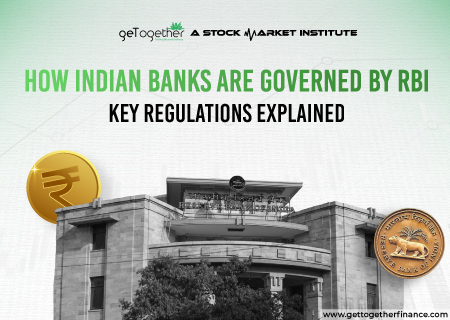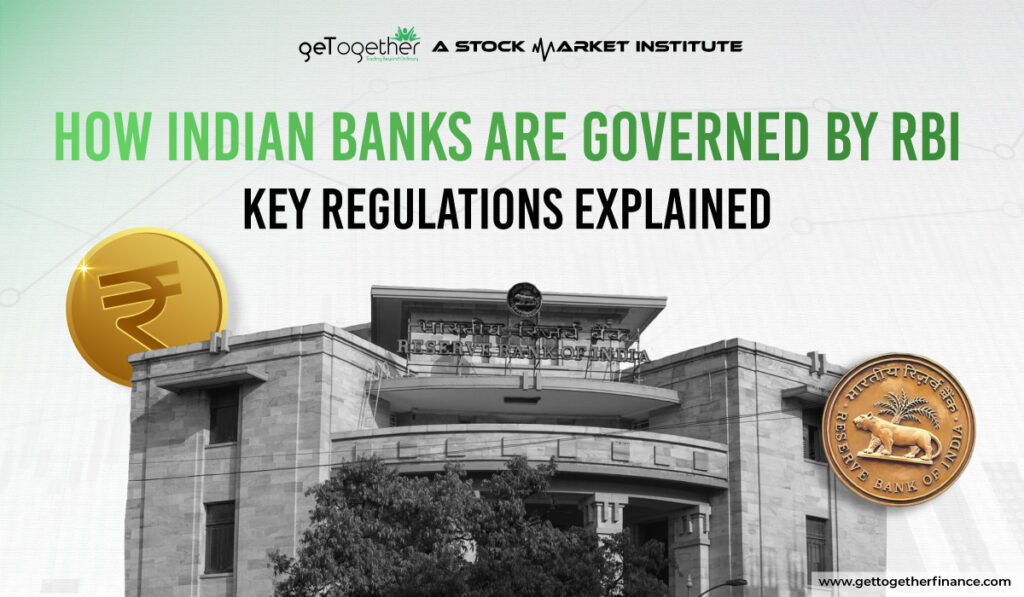How Indian Banks are governed by RBI: Key Regulations Explained
- November 11, 2024
- 744 Views
- by Manaswi Agarwal


The banking sector in India is governed by a set of important rules designed to keep the system stable, protect depositors, and encourage economic growth. At the center of this regulatory framework is the Reserve Bank of India (RBI), which acts as the main regulator for banks in the country. The primary law that guides banking operations is the Banking Regulation Act of 1949. This law lays out the rules for how banks should operate, including how they get their licenses, manage their businesses, and handle financial transactions.
Key RBI Regulations Governing Indian Banking Systems

Now that we know of the primary role of The Reserve Bank of India (RBI) in keeping the banking system in India running smoothly. Here are some important regulations that the RBI has put in place:
Banking Regulation Act, 1949
This is the main law under RBI regulations that governs how all banks in India operate. It sets the rules for things like getting a license, managing operations, and handling finances. Basically, it helps make sure banks are safe and sound.
The act covers all scheduled commercial banks, which include over 90 scheduled banks currently operating in India. According to the RBI regulations, the total assets of scheduled commercial banks were approximately ₹153 lakh crore as of March 2023.
Amendments Over The Years (Act 1949)
Here let’s take a look at the key changes made to the RBI Act, 1949 (Banking Regulation Act):
1965 Amendment Cooperative Banks
- This change made sure that cooperative banks (banks run by a group of people for mutual benefit) also followed the same rules as other banks.
- It gave the RBI more power to control and monitor these banks.
2016 Amendment: Bad Loans
- RBI got the power to tell banks how to handle bad loans (loans that people or companies aren’t paying back).
- It helped banks use the new Insolvency and Bankruptcy Code (IBC) to recover bad loans.
2017 Amendment: Fixing Non-Performing Assets (NPAs)
- This change made it easier for RBI to help banks deal with their bad loans.
- RBI could now order banks to take legal steps to recover money from big defaulters (people or companies not repaying loans).
2020 Amendment: Cooperative Banks Control
- RBI’s regulations over cooperative banks was made stronger to prevent mismanagement.
- RBI could now make sure these banks had good, qualified management to avoid any problems.
Changes for NBFC (Non-Banking Financial Companies)
- Over time, RBI has been given more power to control NBFCs to ensure they manage their money properly and don’t face major financial issues.
These changes were made to keep the banking system safe and strong, protect depositors, and help banks deal with bad loans better.
RBI Act, 1934
RBI Act 1934 gives the RBI the power to regulate and supervise banks. It outlines what the RBI can do, like managing the country’s money supply and keeping the financial system stable.
Under this act, the RBI manages the country’s monetary policy and oversees the banking system, which includes more than 1,500 banks across various categories.
Amendments Over The Years (Act 1934)
Here let’s take a brief look at the key changes made to the RBI Act, 1934:
1934 Act Establishment
- This law set up the Reserve Bank of India (RBI) as the central bank of the country to manage money, control inflation, and keep the banking system stable.
Amendment of 1997: Monetary Policy
- RBI got more control over deciding how much money should circulate in the economy to control inflation and manage interest rates.
- This gave RBI better tools to manage the economy and ensure stability.
2006 Amendment: Government Securities Market
- Allowed RBI to manage government borrowing more effectively.
- It improved RBI’s ability to control the money supply by selling or buying government bonds.
2016 Amendment: Monetary Policy Committee (MPC)
- This change created a new group called the Monetary Policy Committee to help decide the interest rates in India.
- The MPC, which includes RBI members and government-appointed experts, makes decisions on how to manage inflation by adjusting interest rates.
2017 Amendment: Demonetization
- This gave RBI the power to handle large currency changes, like when ₹500 and ₹1000 notes were banned in 2016.
- It also strengthened RBI’s role in managing the country’s currency system.
2018 Amendment: RBI’s Power Over NBFCs
- RBI was given more power to control Non-Banking Financial Companies (NBFCs), which provide financial services like loans but aren’t traditional banks.
- This helped prevent financial problems in these companies from affecting the economy.
Tools to Regulate Banks

Setting Interest Rates
The RBI is in charge of setting important interest rates, like the ‘repo rate’. It is a tool used by the RBI to control inflation and maintain liquidity (the availability of money) in the economy. This is the rate at which the RBI lends money to other banks.
As of September 2023, under RBI regulations, the repo rate is 6.50%. By changing this rate, the RBI can influence how much it costs to borrow money, which helps control inflation and boost economic growth.
Cash Reserve Ratio (CRR)
The CRR is the percentage of a bank’s total deposits that must be kept in reserve with the RBI. It’s like a safety net, ensuring banks have enough cash on hand to meet customer demands. Through CRR, they ensure banks maintain sufficient cash reserves to meet customer withdrawals and promote liquidity in the banking system.
The CRR is set at 4.50% of a bank’s total deposits and NDTL (Net Demand and Time Liabilities). Banks are required to maintain the CRR on a fortnightly basis. However, on a daily basis, they must ensure at least 95% of the required reserves are maintained.
If a bank fails to meet the daily requirement, a penalty is imposed. The penalty is calculated as 5% above the current bank rate, applied to the number of days the bank defaults and the shortfall amount from the prescribed reserve level.
Statutory Liquidity Ratio (SLR)
The SLR is another requirement where banks must keep a certain percentage of their deposits in liquid assets, like cash or government bonds. This helps banks stay liquid and reduces the risk of running into trouble.
The SLR is currently set at 18.00% of a bank’s net demand and time liabilities. This can be held in the form of gold, cash, or approved government securities.
If a bank holds more SLR than required, it can use that extra amount to borrow money overnight from the RBI under the Marginal Standing Facility (MSF). The interest rate for MSF is slightly higher than the repo rate by 0.25%. However, banks can only borrow up to 3% of their total deposits (NDTL) through this facility.
Priority Sector Lending

Under RBI regulations, it is made sure that important sectors, like agriculture and small businesses, get enough loans. So, they require banks to lend a certain percentage of their total loans to these priority sectors.
Banks must allocate 40% of their net bank credit to these sectors, which helps support economic growth and development.
Let’s take a look at the breakdown of allocation:
Lending Targets:
- Domestic and Foregin Exchange Banks (20+ branches): They need to lend 40% of their total credit to these priority areas.
- Smaller Foreign Banks (fewer than 20 branches): They also are required to hit the 40% target for these sectors.
Lending to Farmers (Agricultural Sector):
As per RBI regulations, Banks must lend at least 18% of their total credit to the agriculture sector, or the equivalent of their off-balance-sheet commitments, whichever is more.
Lending to Small Businesses:
- Micro-enterprises: 40% of the lending target should go to businesses with equipment worth up to ₹200,000 and machinery up to ₹500,000.
- Small Enterprises: 20% should go to businesses with machinery valued between ₹500,000 and ₹1,000,000, or equipment worth between ₹200,000 and ₹250,000.
Lending to Weaker Sections:
Banks must lend at least 12% of their total credit or the equivalent of their off-balance-sheet commitments to weaker sections. This includes certain castes, tribes, and small farmers.
Private banks sometimes avoid lending to these sectors due to the risk of high loan defaults.
As per RBI regulations, regular audits and inspections of banks are conducted, with over 200 inspections carried out in the last fiscal year to ensure adherence to guidelines.
As of March 2023, around 1.5 billion bank accounts have been opened under the Pradhan Mantri Jan Dhan Yojana, showcasing significant progress in financial inclusion.
New Bank License Rules As Per Recent RBI Reforms

Here’s a breakdown of the new rules for getting a bank license:
- Proven Track Record: Any group applying for a bank license must have a solid track record of at least 10 years. The bank has to be managed through a special company called a non-operative financial holding company (NOFHC), which should be fully owned by the promoters.
- Restrictions on Securities: The NOFHC and the bank aren’t allowed to hold shares or securities from the promoter group, and the bank can’t hold any financial securities owned by the NOFHC.
- Capital Requirements: The bank needs to have at least ₹5 billion as starting capital. The NOFHC should own 40% of this initially but will need to reduce it to 15% over the next 12 years. Plus, the bank’s shares must be listed on the stock market within three years of starting operations.
- Foreign Ownership: Foreign ownership is limited to 49% for the first five years. After that, the RBI’s approval is needed to increase it up to a maximum of 74%.
- Board of Directors & Lending Targets: The bank’s board must have mostly independent directors, and the bank has to meet the priority sector lending goals (lending to sectors like agriculture and small businesses).
- Rural Branches: At least 25% of the bank’s branches must be opened in rural areas that don’t have banking services yet.
RBI regulations help keep the banking system in India stable and trustworthy, making sure it serves the needs of the economy and the people.
Conclusion
India’s banking regulations, primarily governed by the Reserve Bank of India (RBI) through the Banking Regulation Act, 1949. As the economy evolves, so do the RBI regulations. As per recent RBI regulations, such as stricter norms for issuing new bank licenses and enhanced oversight on non-performing assets (NPAs), reflect the RBI’s focus on strengthening the banking system. It’s worth noting that while the RBI oversees the banking sector, SEBI (Securities and Exchange Board of India) plays a parallel role in regulating and governing the stock market. Together, these bodies ensure that both the banking and financial markets operate in a transparent, efficient, and fair manner, balancing growth with economic security.
FAQs
Can banks lend money to anyone?
No, banks must follow certain rules about who they can lend money to and how much they can lend to a single borrow.
What is Priority Sector Lending?
This is a requirement for banks to lend a certain amount of money to important sectors like agriculture and small businesses to support economic growth.
What happens if a bank breaks the rules?
The RBI can impose penalties or take other actions against banks that do not follow the regulations.
Can the RBI close a bank?
Yes, if a bank is not operating safely or is in financial trouble, the RBI can take steps to close it down.
How does the RBI regulate interest rates?
The RBI influences interest rates through its monetary policy. It sets key rates like the repo rate, which impacts the interest rates banks charge borrowers and pay depositors.
How do banks report to RBI with bad loans (NPAs)?
The RBI influences interest rates through its monetary policy. It sets key rates like the repo rate, which impacts the interest rates banks charge borrowers and pay depositors.
How do banks report to RBI with bad loans (NPAs)?
When someone stops paying back their loan, it’s called a Non-Performing Asset (NPA). The RBI tells banks to keep some money aside for these bad loans and pushes them to try and recover what’s owed.



 Instagram
Instagram 
